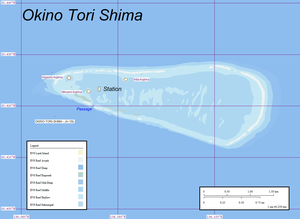Okinotorishima
| Okinotorishima | |
|---|---|
| Oblique aerial view from the west | |
| Waters | Philippine Sea , Pacific Ocean |
| Geographical location | 20 ° 25 ′ N , 136 ° 5 ′ E |
| Number of islands | 3 |
| Main island | Kitakojima |
| length | 4.5 km |
| width | 1.6 km |
| Land area | 0.85 ha |
| Lagoon area | 5 km² |
| Residents | uninhabited |
| Map of Okinotorishima | |
Okinotorishima ( Japanese 沖 ノ 鳥島 , German "bird island in the open sea"; also Parece Vela or Douglas Reef ) is an approximately 4.8 km long and 1.6 km wide and largely submarine atoll with two rocks that emerge at low tide tower over the waters of the Philippine Sea on the Palau-Kyushu Ridge in the northwestern Pacific Ocean . As part of the municipality of Ogasawara , it belongs to the sub-prefecture of the same name and thus to the Tokyo prefecture . It is 1,740 km away from the Japanese capital Tokyo and is the southernmost island and the only “real” atoll in Japan . But Japan still has upscale atolls like the Daitō Islands .
history
Okinotorishima has been part of Japan since 1931. According to the peace treaty of San Francisco , Okinotorishima was transferred to the USA in 1952 together with the Ogasawara archipelago, which both territories returned in 1968.
Erosion and “subsidence” of the rocks and countermeasures
Both islands are in danger of disappearing permanently under the sea surface due to erosion and climate change and the associated rise in sea level. Therefore, in 1987 Kitakojima ( 北 小島 , dt. "North Island") in the west (6.4 m²) and Higashikojima ( 東 小島 , dt. "East Island") in the east (1.6 m²) were fortified by extensive construction measures. In the south, an artificial island , Minamikojima ( 南 小島 , German "South Island"), was created. After the fortifications, each of the islands has a circular floor plan with a diameter of 60 meters, which corresponds to an area of a good 2827 m² per island. The total artificial land area is around 8482 m². 140 meters east-northeast of the artificial island stands a platform on stilts in the shallow water of the lagoon , with a rectangular floor plan of 50 by 100 meters. The platform has a helipad and a three-story building with a meteorological station. The fortifications are supervised and repaired by a regional branch of the Ministry of Transport.
The rocks are in the western part of a lagoon formed by an underwater coral reef. This extends 4.5 km in the east-west and 1.7 km in the north-south direction with an area of about 5 km². The lagoon is about 3 to 4.6 m deep with numerous slightly elevated spots. The bounding reef is arrow-shaped in an east-west direction with the greatest extent in the east. In the south-west is the entrance of a 15 m wide and 6 m deep boat channel 250 m from the artificial platform.
Since 2006, the Japanese State Fisheries Agency has planted 40,000 new corals in the area . The special thing about it is that the "eggs" of the three types of coral used here come from this coral reef itself. For rearing they are brought to warmer, less turbulent waters on the southwestern island of Okinawa . After the rearing, the corals are brought back to Okinotorishima. There they are supposed to stop the erosion of the strategically important islands for Japan . The corals are looked after by the marine biological station on the platform.
Status dispute
The People's Republic of China has contested the current status of the two land surveys since 2004. In their opinion, the two islets are not " islands ", just " rocks ". Due to the current status, Japan is entitled to approximately 400,000 km² of sea area under the Law of the Sea . However, this dispute is not only about economic interests, but also, for the People's Republic of China, about better military control of the waters around Taiwan .
See also
Individual evidence
- ^ A b c d "DIY coral is secret of economic growth", The Times (London), SECTION: OVERSEAS NEWS, Pg. 34, April 25, 2006.
- ↑ a b c Der Spiegel, magazine, No. 08/23 (02.060.08), p. 111
- ↑ Okinotori ( Memento of December 23, 2005 in the Internet Archive ) on keihin.ktr.mlit.go.jp, accessed on June 29, 2018.
- ↑ Kenji Miyaji, Akito Sato, Koji Watanabe, Wataru Ando, Noboru Ishioka, Ryota Nakamura, Hidekazu Yamamoto, Akira Watanuki: Development of Coral Propagation Technologies in Okinotorishima Island , 2008.
Web links
- Keihin website with images of the rocks from 1987, in Japanese
- A picture of one of the fortified elevations
- japanese map


